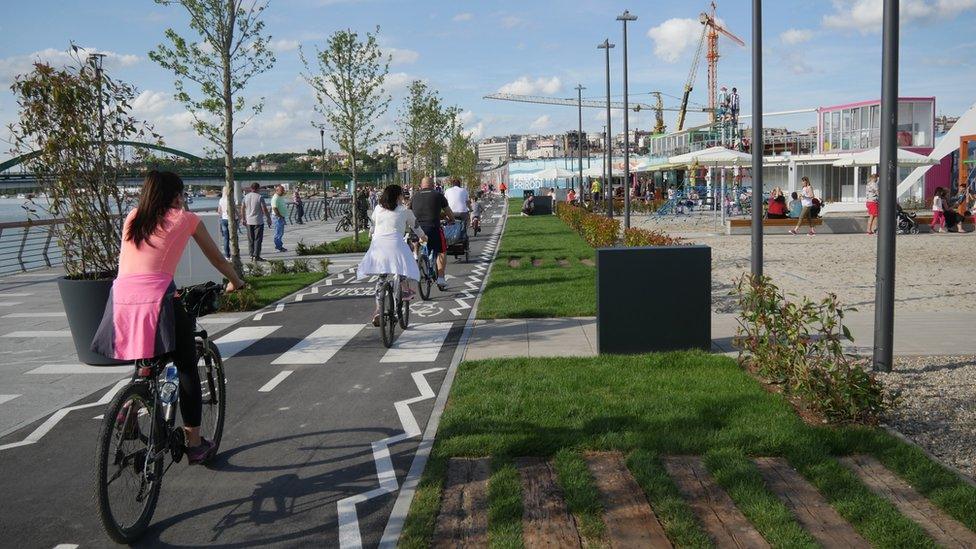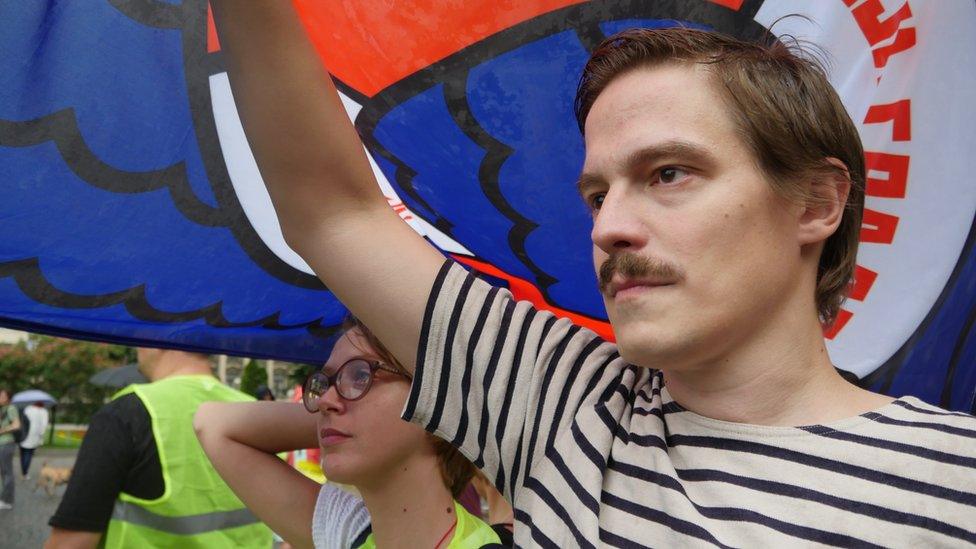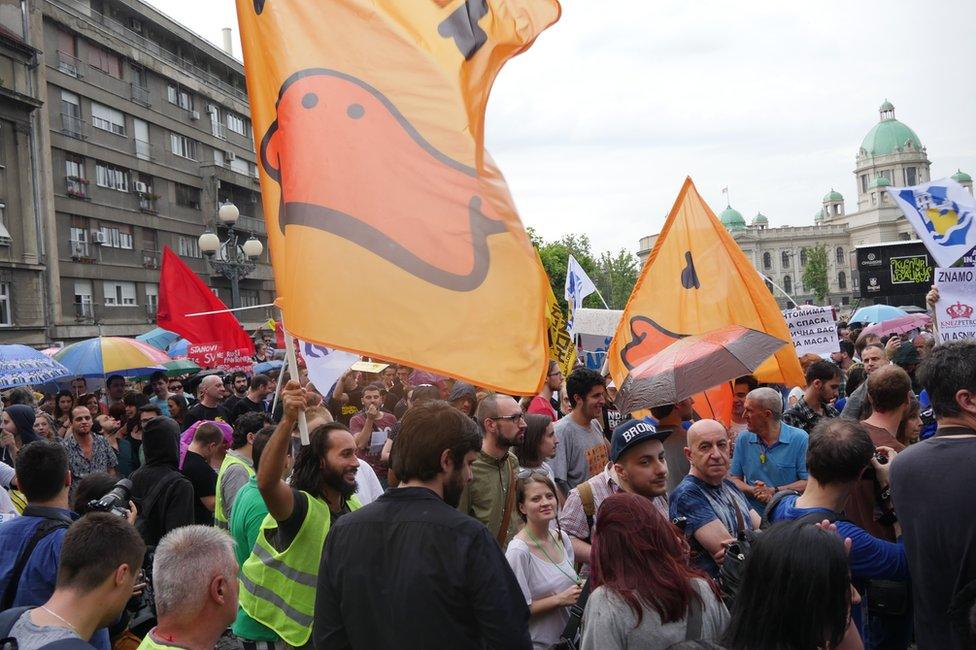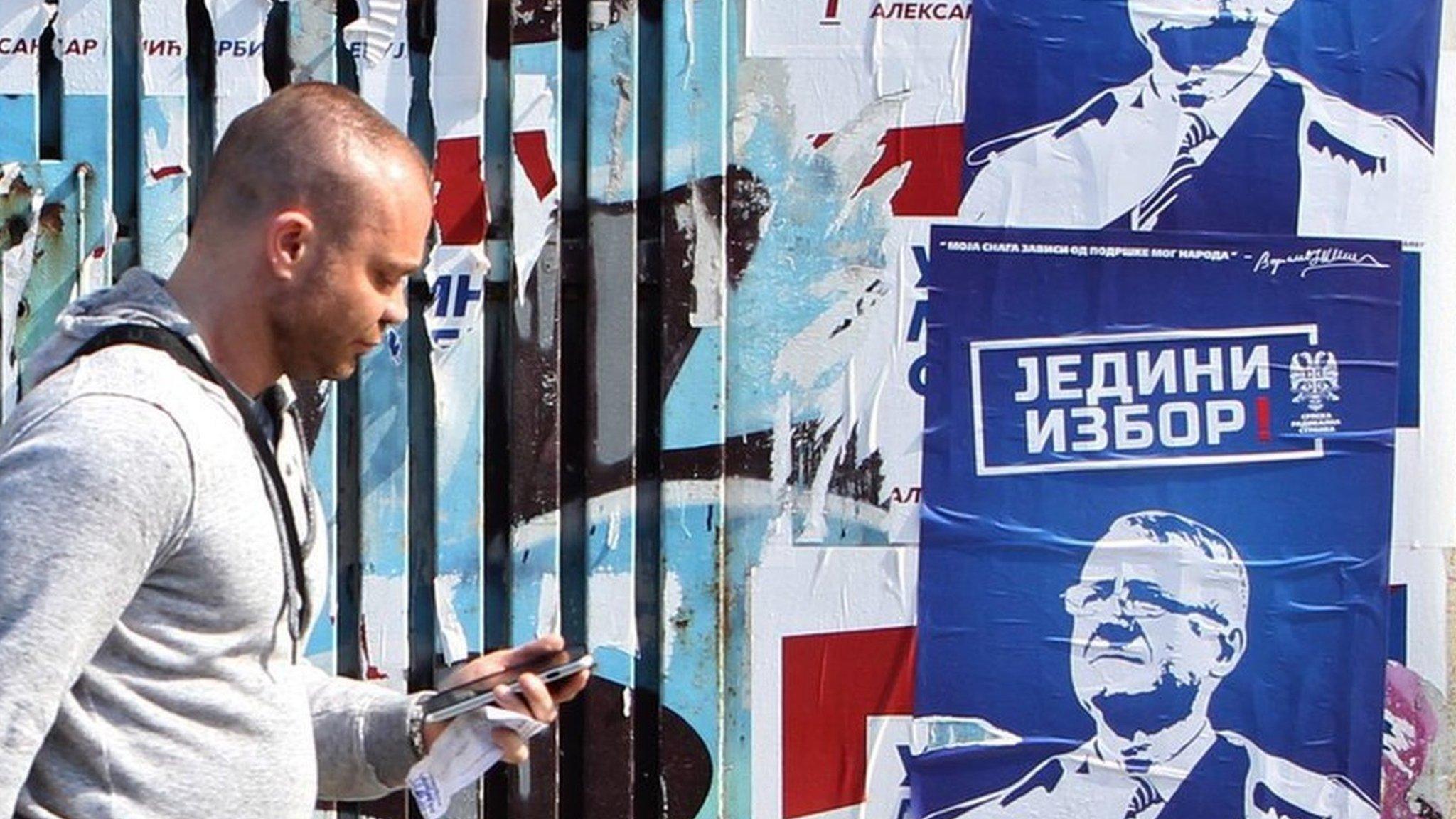Controversy surrounds Belgrade Waterfront development
- Published

A massive advert for Belgrade Waterfront stands in front of the city's train station
Belgrade's main railway station is a beauty. Completed in 1884, its yellow-washed facade carries echoes of the Hapsburg and Ottoman eras and reflects nostalgia for the time when the Orient Express used to call here.
The same can hardly be said for the surrounding area. It has the usual transport terminal trappings: rundown hotels, greasy fast-food joints and taxis whose meters may or may not correctly reflect the tariff.
Behind the station there is a railway yard with graffiti-daubed, rotting rolling stock obstructing access to the Sava riverfront, just a matter of metres away.
But all this is set to change. A massive hoarding on the front of the station depicts a future which seems to have beamed in from a parallel universe - or, at the very least, a different country.
It features a gleaming tower surrounded by shops and parks on the banks of the river. And underneath, the logo and contact details for the Belgrade Waterfront development.

"Belgrade Waterfront is a project for which the city has waited for more than 50 years," says Milutin Folic, the head of Belgrade's city planning department.
"After the Second World War, we had plans to relocate the train and bus stations and free the important and central area of brownfield for the city to expand towards the rivers. With Belgrade Waterfront, a city which sits on two rivers will finally reach the water.
"It will bring urban ideas to daylight, put the construction industry back on its feet - and we hope other parts of the economy will see the benefits."
Project concerns
The entire project is worth more than €3bn (£2.3bn; $3.4bn) - and could take 30 years to complete. By its end, Belgrade should have a new opera house, shopping centre and luxury hotels and apartments. There should also be much-improved access to the riverfront, currently a glaringly underused resource.

The entire project will take decades to complete
But support for Belgrade Waterfront is far from universal.
Initially, reservations focused on the recent revival of the riverfront Savamala district, which overlaps the area under development. It has become a cultural hub, with galleries, arts centres and nightlife attracting crowds of overseas and local visitors. Its supporters fear that some or all of this might be lost in the fervour to revamp the city.
Then there were concerns over the bidding process - or rather, the lack of one. The government and city authorities simply appointed Eagle Hills, a developer based in Abu Dhabi, the source of the funding for the project. Opponents say it is far from clear how Belgrade Waterfront's costs will be met.

Luka Knezevic Strika has questioned the bidding process and whether citizens would benefit from Belgrade Waterfront
"The government said there would be no tender because 'we have the best investor already'. They just announced it would be done this way and covered it by changing the laws where necessary or just ignoring them where they couldn't change them," says Luka Knezevic Strika, a visual artist who opposes Belgrade Waterfront.
"I don't mind cleaning up the trash - but not when the price is giving away the land where the trash stood. Making expensive housing doesn't have any benefit to the citizens. Leaving it as it was would have been better - we would have been richer for a future when we could have developed it as we wanted."
Duck protests
This partly explains why a crowd of thousands is spending the early part of their Saturday evening gathering in front of Belgrade City Hall, blowing whistles and waving flags emblazoned with a cartoon of a yellow rubber duck.

Thousands of people have protested with symbolic duck images
"The word duck in Serbian means fraud," explains Luka Knezevic Strika. "It's a symbolic way of saying the project is really Belgrade Water-fraud."
But it is not just the lack of transparency that concerns the campaigners. They were formerly a small but determined group who called themselves Ne Davimo Beograd ("Don't Drown Belgrade"), but their numbers have swollen since a bizarre and disturbing incident at the end of April.
Just hours after polls closed in the general election, masked men armed with baseball bats enforced the overnight demolition of several Savamala buildings that stood in the way of Belgrade Waterfront.
Thousands of outraged citizens joined the Ne Davimo Beograd campaigners in a series of protests before Prime Minister Aleksandar Vucic admitted, at the start of June, that city officials were behind the episode, external.
"I'm afraid for the system when events like this happen," says Knezevic Strika. "There can't be good intentions behind something that turns out to be government-sponsored terrorism."
Troubled history
The incident has also overshadowed Belgrade's dire need for economic stimulus and infrastructure development. This city of two million has long been one of the largest, most important and vibrant in south-east Europe. But the past 25 years have not been kind.
The violent disintegration of Yugoslavia brought an international embargo and hyperinflation, as well as Nato bombs.
Then just as newly independent Serbia was emerging from the literal and metaphorical rubble, the European financial crisis hit it particularly hard.

Belgrade's planning chief, Milutin Folic, says the city has waited a long time for a project like Belgrade Waterfront
James Thornley, senior partner at the Belgrade office of auditors KPMG, says there is a good business case for a development like Belgrade Waterfront.
"Everything stopped on commercial development 10 years ago, and now there's a shortage. If a major investor came to us and asked where they could locate 500 or 1,000 people, we would struggle to advise them.
"There really is potentially a demand for what's being offered - opportunities for the place to be a hub where people can live and work have to be a positive thing."
'Positive direction'
Some changes are already apparent. Riverfront renovations have produced a promenade with playgrounds, a beach volleyball court, and food and drink outlets. It is already well used by a mix of families, cyclists and cocktail drinkers.
Meanwhile, construction of the Belgrade Tower and the high-end W Hotel can be seen through transparent windows on nearby hoardings. Belgrade's planning chief, Milutin Folic, sees it as a clear improvement for citizens.
"The balance is so far in favour of the project - it really changes the area in a positive direction. It's not like we're destroying an historical area and building something new. We're actually not destroying anything - we're turning brownfield into an urban area," he says.
While the new riverside leisure area already seems a popular success, the protests are likely to continue. People in Serbia have learned to be deeply suspicious - after decades of dodgy sell-offs and promises that all too frequently have come to nothing.
At the very least, Belgrade Waterfront now needs to do a lot of bridge-building to show it is not going to fall into that category as well.
For more on this story listen to Business Daily.
- Published2 March 2017
- Published25 April 2016

- Published24 April 2016
